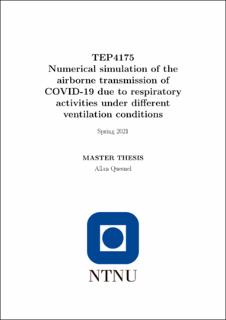| dc.description.abstract | Covid-19 pandemic have recently raised lots of issues about the way we lived socially and have led
to various studies for our social behaviour to be adapted to struggle the crisis. This report presents
the work done during the master thesis regarding this virus contamination. The goal of this thesis
was to understand and evaluate the infection risk under different ventilation conditions, between
a standing and infected person, and a sitting one. Therefore, a CFD study has been performed in
parallel with another thesis containing relevant experiment data. To achieve a model coherent with
this data, we use a whole process: literature review to collect data and get used to CFD problems
in indoor environment, simplified geometry and mesh to understand the available CFD models,
mesh study to perform efficient and accurate calculations, additional experiments to improve the
model, After validating the model with experimental data, we can observe the virus concentration
in the room and deduce which configuration is the best to limit contamination. CFD study shows
the experiments realized hide some critical points where the risk of infection is the highest during
the exhalation of the infected person. | |
